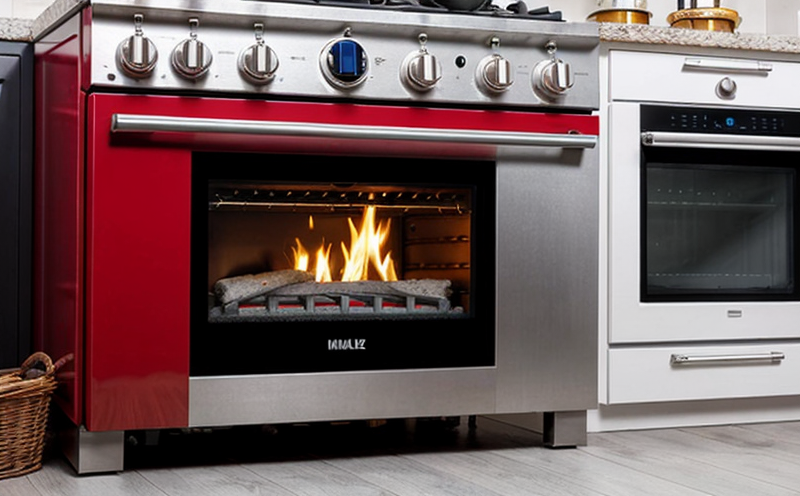Heat Release Rate Measurement During Appliance Combustion
In the realm of fire safety testing, particularly within household appliances, understanding the heat release rate (HRR) during combustion is crucial. The HRR represents the amount of heat energy released per unit time from a burning material or device. This metric is vital for ensuring that products meet stringent safety standards and protect consumers from potential risks associated with appliance fires.
During the combustion process, appliances such as stoves, ovens, heaters, and other household equipment can produce flames under various conditions. The heat release rate measurement during these events helps identify how quickly a material or appliance will ignite and how much energy it releases in that state. This information is critical for product development, compliance with fire safety regulations, and the enhancement of consumer protection measures.
The testing process typically involves subjecting an appliance to controlled combustion scenarios under specified conditions. The apparatus used includes calorimetric systems designed specifically for measuring HRR. These systems capture the heat released by the burning material over time, providing valuable data on its flammability characteristics and overall safety performance.
Standard procedures for conducting these tests are governed by international standards such as ISO 56601-2:2018 for gas-fired appliances and EN 300447-1:2018 for electric appliances. Compliance with these standards ensures that the test results are accurate, reliable, and comparable across different manufacturers and regions.
The heat release rate measurement process begins with careful preparation of the specimen to be tested. This involves ensuring that the appliance is in optimal condition for combustion testing, including cleaning any residual materials or debris from previous use. The specimen must also be set up according to the specified test conditions to ensure consistency across trials.
During the actual testing phase, the apparatus captures the heat released by the burning material over time using calorimetric sensors. These sensors measure the temperature increase in a controlled environment, allowing for precise calculations of the HRR. The data collected is then analyzed to determine the peak heat release rate and total energy released during combustion.
The results of these tests are critical for several reasons. Firstly, they provide valuable insights into the flammability characteristics of household appliances, helping manufacturers identify areas for improvement in product design and materials selection. Secondly, compliance with fire safety regulations is essential to ensure that products do not pose a risk to consumers. Lastly, the test data can be used to inform consumer education campaigns, promoting safe appliance usage practices.
Understanding the heat release rate during combustion also aids in the development of more efficient and safer appliances. By identifying the factors that contribute to high HRR values, manufacturers can work towards reducing these risks through improved design and material choices.
In conclusion, measuring the heat release rate during appliance combustion is a critical aspect of fire safety testing for household appliances. It provides essential data on product flammability, helps ensure compliance with relevant standards, and supports continuous improvement in product safety. This service plays a vital role in protecting consumers and enhancing overall public safety.
Benefits
- Enhanced Product Safety: Ensures that household appliances meet stringent fire safety requirements and do not pose risks to users.
- Informed Decision Making: Provides valuable data for product development, enabling manufacturers to make informed decisions about design improvements.
- Compliance with Regulations: Helps ensure compliance with international standards like ISO 56601-2:2018 and EN 300447-1:2018.
- Consumer Confidence: Builds trust by demonstrating a commitment to product safety and quality.
The benefits extend beyond just the immediate testing process. By identifying potential hazards early in the development cycle, manufacturers can prevent costly recalls and improve brand reputation.
Eurolab Advantages
At Eurolab, we pride ourselves on providing comprehensive fire safety testing services tailored to meet the unique needs of our clients. Our expertise spans various sectors, including household appliances, electronics, textiles, and more. With state-of-the-art facilities and experienced professionals, we offer a range of services designed to ensure compliance with international standards.
Our team of experts ensures that every test is conducted according to best practices and industry standards. We employ cutting-edge technology and instrumentation to deliver accurate and reliable results. Our commitment to quality and customer satisfaction sets us apart from other testing laboratories.
We understand the importance of timely delivery in the product development process. That's why we offer fast turnaround times without compromising on accuracy or reliability. Whether you need a single test or an extensive series, Eurolab is here to support your needs with flexibility and efficiency.
Our clients benefit from our deep understanding of fire safety regulations across different regions. This knowledge allows us to provide guidance on how to navigate these requirements effectively, ensuring that products are compliant worldwide.
Environmental and Sustainability Contributions
- Emission Reduction: By identifying flammable materials early in the development process, we help reduce emissions associated with product failures or recalls.
- Resource Efficiency: Improved design based on test results leads to more efficient use of resources during manufacturing and production.
- Energy Conservation: Safer appliances contribute to energy conservation by reducing unnecessary power consumption and heat generation.
The environmental impact extends beyond just the testing process itself. By promoting safer, more sustainable product designs, we contribute to a greener future. Our commitment to sustainability is reflected in our continuous efforts to improve test methods and reduce waste.
Through our fire safety testing services, we aim to promote a safer environment for all consumers while minimizing the ecological footprint of household appliances throughout their lifecycle.





